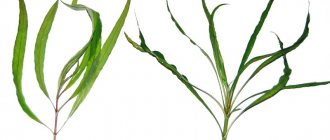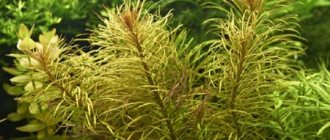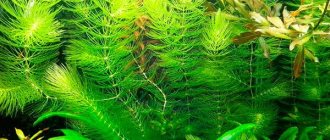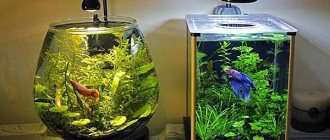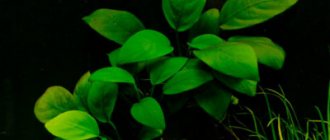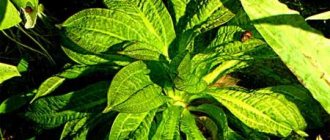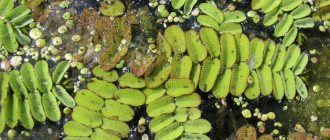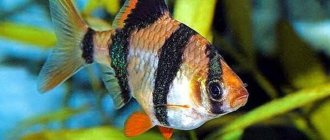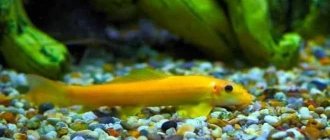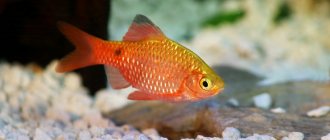Living in the wild
Cladophora globulus is a type of algae that resembles moss in appearance. Other names for the plant are moss ball, lake moss, and its scientific name is Linnaeus' aegropylus. In Japan, Cladophora is known as marimo, which translates to “bouncy ball.”
In the wild, the algae grows in water bodies of Asia, Europe, Japan and Iceland. Cladophora feels great and reproduces in clean, fresh and cool waters of rivers and lakes at a depth of 2–3 meters, where the water temperature is from 18C to 24C. Thanks to the slow flow, the spherical cladophora acquires a rounded shape, rolling along the bottom.
The ability of lake moss to move allows the plant to constantly synthesize organic components, which makes the plant independent of the type of soil. In the morning and afternoon, the moss ball rests calmly at the bottom, and in the evening it floats at the surface of the water. The change in location occurs due to the accumulation of air bubbles, causing the algae to rise upward. If you get rid of them, the plant will go down again.
Cladophora globulus is not a higher aquarium plant, but a type of algae that has become popular among pond owners due to its unusual shape and ability to purify water.
Cladophora contents reproduction description photo species
Cladophora USEFUL PROPERTIES
Cladophora in an aquarium serves not only to create a decorative effect (and this is precisely why aquarists value it). This nice colony of algae is an additional source of oxygen, as well as a very good natural filter, since the volume of water passing through it is quite significant. Particles of food and waste products of the inhabitants of the aquarium accumulate on its velvety surface, so cladophora purifies the water.
That is why Cladophora is very appropriate in nursery aquariums with fry and small crustaceans. Shrimp happily feed on the delicate strands of algae that make up the colony. And the fry find in it the simplest microorganisms, ciliates, which willingly inhabit its body and serve as food for them.
We recommend reading: Pushkin breed of chickens - characteristics, description, reviews with photos
CONTENT
In order for the cladophora plant to fully develop throughout the year, it is necessary to keep it in an aquarium with sufficiently cold water. The water temperature should not exceed 18-20 degrees. At higher water temperatures (above 22 degrees), rapid growth of the plant begins. It loses its regular spherical shape and breaks up into sloppy fragments that can clog the aquarium filter grille.
Plant decay can also be caused by hard and medium-hard water. For comfortable growth, cladophora needs soft water with a hardness of no more than 7 degrees. The required acidity of water is (pH) 6-7. An alkaline environment is detrimental to it.
In order for the plant to maintain its attractiveness, it needs very clean water. Therefore, both constant filtration and regular water changes (up to 30% of the total volume) are necessary.
If plaque appears on the surface of the ball, rinse it under running cool water and lightly squeeze it out by hand.
The lighting intensity in the aquarium should be moderate. Both artificial light from fluorescent lamps and natural lighting are equally suitable. Cladophora algae is quite capable of withstanding moderate salt content (no more than 5%) in water, so it can be used in a saltwater aquarium.
The composition of the soil does not matter, since cladophora balls do not attach to the substrate.
Cladophora aquarium plant PHOTO
Volume of reservoir for cladophora
Not significant. Therefore, it can be recommended as a plant for nursery tanks with fry. It is possible even with an elevated temperature. For a short time, Cladophora globulus can withstand temperatures of up to 26 degrees Celsius.
Soil for Cladophora globulus
Egagropyla does not need soil at all. It is attached to it extremely rarely. Most often thanks to the efforts of the designer.
Water parameters for keeping cladophora
As already indicated, in order to preserve the egagropila in the form of a ball, it is necessary to maintain the water temperature no higher than 22 degrees Celsius. For a short time, you can decorate a tropical underwater landscape with this plant or increase the temperature to speed up its growth. But if the elevated temperature lasts longer than two months, the colony may disintegrate.
Therefore, you can suggest keeping it in a tropical pond, if your design is not possible without it, for no longer than one and a half months. Then transfer it to a cold-water aquarium for 1 - 1.5 months to stabilize the colony. Hard and alkaline water also contributes to the decomposition of Cladophora globulus. It is advisable to keep the hardness at a level of no more than 8 – 10°dH. pH 6.5 – 7.
Natural specimens are found at fairly great depths (up to 30 meters). Relatively little light penetrates to such depths. But in an aquarium you should not strive to create deep-sea twilight. The average illumination of your underwater garden is sufficient, provided by fluorescent lamps with a total power of about 0.5 W/l.
Aeration for Cladophora
The need for additional artificial aeration is determined by the needs of other inhabitants of the aquarium.
Filtration for Cladophora
Cladophora globulus loves clean, transparent water. Therefore, it is highly desirable to provide an external or internal filter that would purify the water from turbidity and small suspended particles. Even with
In the presence of a filter, a sponge formed by threads of algae deposits the smallest turbidity on itself, thereby acting as a natural filter. Therefore, from time to time, the spherical cladophora should be removed from the reservoir and washed under a gentle stream of tap water. Then gently, gently squeeze it out, after which it can be put back into its original place.
Egagrosaw compatibility
He doesn’t conflict with anyone, doesn’t shade anyone, doesn’t claim anyone’s place in the sun. Can be kept with almost any other species with similar conditions.
Cladophora nutrition
Cladophora globulus responds positively to CO2 feeding, but develops quite satisfactorily without it. Fertilizing with mineral fertilizers is unnecessary. Egagropyla has enough nutrients that enter the underwater garden with fish food and with a weekly change of one-fifth of the water.
Cladophora. Reproduction
Cladophora globulus reproduces by dividing the colony. Fragmentation can occur as a result of temperature increases above 22 degrees Celsius, hardness above 10°dH, active reaction of the environment above
Cladophora aquarium plant PHOTO
DESCRIPTION
Cladophora globulus is an unusual plant that looks like a dense fluffy ball of dark green color. It is formed by a colony of green filamentous algae arranged radially.
This aquarium plant was described by Carl Linnaeus in 1753. It has also lived behind the glass of domestic ponds since time immemorial. This is facilitated by both the unpretentiousness of the plant and its original appearance, and if you cut it, you will get an amazing green mat with which you can cover part of the bottom, thus creating a green underwater lawn.
Despite the external resemblance to moss, it is not moss or a higher plant at all, but an algae. Algae is generally undesirable in aquariums, but this furry, cute creature is an exception. It does not spoil plants, walls and decorative elements. The algae colony has the shape of a ball, which makes its appearance extremely unusual. The entire colony lives on the surface; inside, the ball consists of dead parts of algae in the form of elastic intertwined threads.
This is a kind of sponge that not only has an unusual appearance, but also passes a large amount of water through itself, acting as a filter.
Cladophora globulus has a fairly extensive range, including all of Eurasia - from the Atlantic to the Pacific Ocean. But this plant is found in nature mainly in cool and clean mountain lakes or old lowland reservoirs with clean water.
In natural reservoirs, Cladophora usually lives in shallow areas. At dawn, when the sun's rays reach the algae, they begin to produce oxygen. As a result, bubbles soon appear inside the ball, which impart positive buoyancy to the cladophore and it floats up. On the surface of the water, under the influence of waves and wind, this colonial algae is washed to the shore or thickets of plants. With the onset of darkness, the oxygen in the bubbles is gradually consumed, the plant loses its buoyancy and sinks to the bottom again. A similar daily cycle of the functioning of Cladophora can be observed in a normally lit aquarium.
Cladophora globulus is an algae, but this algae is not harmful like most of its other brothers, but is very useful and attractive. Using it to decorate your underwater kingdom opens up great possibilities for you. It itself has a rather unusual and original appearance, and its use to cover the ground as a pillow or rug can turn the bottom of your aquarium into a picturesque lawn.
Lighting
Natural specimens are found at fairly great depths (up to 30 meters). Relatively little light penetrates to such depths. But in an aquarium you should not strive to create deep-sea twilight. The average illumination of your underwater garden is sufficient, provided by fluorescent lamps with a total power of about 0.5 W/l.
Green algae are considered enemies of the small aquatic ecosystem. The exception is Cladophora globulus, the contents of which not only decorate the aquarium, but also create a favorable environment for its inhabitants.
Appearance and structure
Cladophora, the structure of which is distinguished by its originality, is a dense volumetric ball. The structure of moss is visually similar to felt. Inside the round moss ball are thousands of threads arranged in a radial direction, forming a frame. In adults, Egagropyla does not contain filamentous algae inside.
Aquarium Cladophora plants have their own daily cycle, which is divided into two moss states:
- staying at the bottom;
- stay near the surface.
The location of moss balls depends on the time of day and oxygen bubbles in the plant structure. As soon as the spherical cladophora gets rid of the air, it immediately sinks to the bottom of the reservoir.
Due to the absence of roots, the plant does not need soil. A dark green ball of elastic algae, floating peacefully in the water column or covering the bottom, gives the aquarium design originality and naturalness.
Kinds
Aquarists encounter two types of Cladophora:
- Globular (Egagropyla Linnaeus) is a noble plant that is specially placed in the aquarium as decoration. It looks beautiful in water and has a number of useful properties. In appearance it resembles a ball, velvety and soft.
- Stray - it is not specifically placed in the aquarium, but is usually brought along with other plants or on the scales of fish. It consists of hard filaments that float in the aquarium and multiply quickly.
Other species of this plant are not found in aquariums, but are found only in rivers or other bodies of water.
Keeping in an aquarium
Keeping algae in a pond is not recommended in the aquarium hobby, as they pollute the water and can cause deterioration in the condition of the fish. However, Cladophora globulus is an unusual algae that brings benefits to the inhabitants of the aquarium and the aquatic environment. It is a biological filter, purifying water from contaminants and saturating it with oxygen. In addition, Cladophora reproduces easily in an aquarium and looks great. For life expectancy and aesthetic appearance, it is necessary to maintain certain conditions and water parameters.
Cladophora spherical, the maintenance of which does not require much effort and time, can be placed in an aquarium of any size. Water indicators should be as follows:
- acidity – 4-6 units;
- hardness – up to 7 units;
- water temperature – 22C.
It is not recommended to exceed the water temperature, since reproduction and breeding of aegropile occurs when the temperature increases to 24C. In addition, in too warm water, the cladophora plant loses its beauty, growing inaccurately and losing its rounded shape. The mosses are restored to their previous appearance by lowering the temperature of the aquatic environment to cool for a month.
Also, algae are demanding on the purity of water, so replacement is carried out weekly, renewing 1/3 of the liquid. To contain Cladophora, you will need to install a filter in the aquarium.
Lighting for the pond is used moderately, with dim light. Too strong and bright rays initiate the accumulation of oxygen bubbles in the spherical cladophora.
Content
Successfully keeping Cladophora in your aquarium is not at all difficult, and even a novice aquarist can easily cope with this task. In general, these algae require the following conditions:
Water temperature . This aquarium moss grows much better in cool water. Ideally, the temperature should be 18-20 degrees. If you raise it a little higher, algae will begin to actively develop. However, at the same time it will become less strong, and the collapse of the colony may occur. That is, cladophore will no longer be in the form of a ball. It will fall apart into separate pieces that can clog the filter;
Rigidity . In mountain lakes the water is soft, and therefore, accordingly, it is better to maintain this parameter for cladophora. You can soften it by regularly adding melt water. If the indicator is above 7°, then this, again, can provoke the collapse of the colony;
Acidity . The optimal indicator is 6-7 pH;
Substitutions . The main and necessary condition is the cleanliness of the aquarium. Therefore, replacements need to be done regularly, weekly about 30% of the total volume;
Soil . The aquarist can choose absolutely any substrate, since these balls do not take root and feed exclusively from the thickness, and not from the soil;
Lighting . It should be moderate. Light from LEDs or fluorescent lamps is suitable. Intensity – about 0.5 W/l;
Aquarium volume . Doesn't matter. Therefore, cladophora is often thrown into spawning grounds where the fry live. For them, this is an additional source of air and food;
Filtration .
Considering that these algae require clean water, then, accordingly, you need a good filter. The internal type is also suitable. But, no matter what the filtration, the lump will still periodically be covered with plaque, since it also absorbs contaminants. Therefore, sometimes it needs to be taken out of the aquarium and washed under the tap, squeezing it lightly.
Caring for Cladophora globulus
There is nothing complicated in maintaining moss balls; the main thing is to care for the algae by changing the water and cleaning the moss. If the spherical flowers have acquired a dark brown tint, then it is time for water treatments. The aquarium plant is washed in cool water, gently squeezing after a shower, returning the original green color.
Egagropila does not always have the shape of a perfect ball - sometimes the structure of aquarium moss changes, forming an oval or another shape. In this case, the plant is rolled over from time to time to return to its previous spherical shape. Aquarists also give the algae not only the shape of a three-dimensional circle, but also trim the Egagropila so that it covers the bottom of the reservoir with a green carpet. To achieve this result, the ball is divided and pressed so that the halves become flat, and then attached to stones or soil using fishing line.
How to plant
One of the features of the aegropile is that it does not need soil for planting. Under normal conditions, it is laid out on the bottom and then moves freely around the aquarium. During the daytime, the process of photosynthesis is activated in its threads, as evidenced by the appearance of small bubbles on the surface of the balls. At this moment the algae floats up. As oxygen is consumed, they sink to the bottom. This usually happens in the evening.
Some aquarists prefer that the algae does not float in the water, but only decorates the bottom. In this case, they carefully open the ball with scissors (you need to wash it first and use only a treated tool), and then lay out the resulting flap on a large stone, securing it with fishing line. The resulting decoration is lowered into the aquarium. After some time, the fishing line will not be visible, and the algae will completely entangle the stone.
Compatibility
Egagropila is most often planted in spawning grounds and nurseries, as well as in aquariums with shrimp. They eat thin threads of algae well, thus removing overgrown parts, and the fry feast on ciliates that accumulate in the structure of the plant.
Before placing mosses in an aquarium, you should consider the requirements of other fish and plants. Cladophora does not like warm temperatures, so you should select neighbors for it, taking this feature into account.
Globular algae are not friendly with catfish, crayfish and goldfish. They actively eat the plant, so if such phenotypes are present, there will be little left of the moss balls. Shrimp also like to eat mosses, or hide between thin threads, but they keep Egagropilus with them if there are not very many shrimp.
This is interesting: in Japan, cladophora is a family plant, and is passed on from father to son. According to legend, the one who gets rid of the aegagropile will be unhappy.
What aquariums is it suitable for?
Cladophora is perfect for any type of aquarium; it does not attach to the soil, so the decorative effect of the plant will depend only on the volume of the aquarium and the number of cladophora balls in it.
Therefore, this plant is often placed in a spawning tank where fry grow. For them, cladophora will simultaneously be a source of oxygen and natural food.
Cladophora looks great in aquariums that imitate natural bodies of water.
Reproduction
Reproduction of spherical mosses occurs vegetatively, and is carried out in two ways:
Algae naturally reproduce at a temperature of 26C, breaking up into separate fragments, from which new colonies are then formed. Mechanical breeding of Egagropyla occurs as follows:
- water hardness is increased by 2–3 degrees;
- a small piece is separated from the plant;
- part of the moss is transplanted into a separate container.
Egagropila has a slow growth, and during the year it increases in size by 10 mm. Complete formation of mosses takes one or two years. It will take about fifteen years to grow a large round ball with a diameter of 20 cm.
Cladophora globulus is a striking representative of the underwater plant world. Mossy balls decorate the design of the aquarium, clean the aquatic environment and serve as food and shelter for the inhabitants of the reservoir. It is easy to maintain such a beautiful plant, and it is not difficult to care for.
Reproduction of the Cladophora colony
Reproduction is quite simple and occurs by simple division of the colony. This can also happen naturally. When the temperature rises to 25-26°C and the lighting increases, the colony begins active and rapid growth, and itself breaks up into fragments. Such pieces are then collected and placed in a separate vessel with clean water, where moderate lighting and a temperature of 20 ° C are already created. Egagropyla grows very slowly. The growth and formation of new colonies will last a year or two, growing by 10 mm per year.
You can also mechanically divide the cladophora ball into pieces and germinate new colonies from them.
Cladophora globulus
The diversity of underwater flora is very large. One of the ingredients is algae. These include the spherical cladophora or Aegagropila linnaei. There are several other common names: ball moss, moss ball. In Japan, it is known as marimo (bouncy plant ball), and the “ghost of the lake.” At the beginning of the 21st century, a second classification name was assigned to Aegagropyle Linnaeus (after the name of Carl Linnaeus, who described it in the 18th century).
History of the study of Cladophora
At one time, the active spread of Cladophora throughout the natural water bodies of European countries contributed to the rapid study and classification of this plant. The first scientist to describe Aegagropyla in detail was the famous Carl Linnaeus. In the middle of the 18th century, this Swedish naturalist presented to the world his scientific work, in which the plant under study was named Conferva aegagrophilia - “leafless algae” (the closest in meaning, an exact translation into Russian is impossible).
The study of this algae began in the 18th century.
Since then, in scientific terminology, the designation of Cladophora has changed several times. Experts could not come to a consensus until 2002, when biologists decided to call Cladophora in the scientific field Aegagropila linnaei (in Latin - Aegagropila linnaei) in honor of the great researcher who was the first to study this plant.
Unlike scientists, who nevertheless came to an agreement on the name Cladophora, ordinary lovers of aquarium flora call the plant differently:
- ball moss;
- mossy ball;
- lake moss, etc.
Residents of Germany call this plant Russian moss ball. And the Japanese poetically call the egagropile marimo.
External characteristics
The structure of Cladophora surprises and attracts attention. An even ball of dark green color located in an aquatic environment. The Cladophora plant is woven from filamentous algae that form colonies with radial arrangements. The surface structure is similar to felt. The inner part of the colony becomes empty with age, dying, leaving a semblance of a frame of intertwined elastic threads.
By cutting the ball, you can get an unusual carpet for the bottom area, with the aim of creating a green area under water with moss.
Content Features
To preserve the beauty of the algae and its growth, it is necessary to organize optimal conditions in the aquarium. Otherwise, the spherical cladophora will begin to disintegrate into fragments, becoming shapeless.
Egagropyla loves cool water. An increase in temperature above 18-20ºС stimulates rapid growth and after 2-3 months the algae loses its spherical shape. First, the ball spreads to the sides, then splits into parts. Therefore, if the design idea requires the presence of cladophora in an aquarium with warm water (above 22ºC), then it can stay there for no more than one and a half months. Next, a month-long period of stabilization and rehabilitation in a cold-water tank will be required.
The moss ball also places certain demands on hydrochemical parameters. It needs soft water. Increased rigidity provokes the disintegration of the ball. The active reaction of water should be close to neutral.
The algae does not lose viability in brackish water, and can withstand a level of 5 ppm.
Cladophora can only feel comfortable in clean water, so filtration and regular replacements (up to 30% weekly) are mandatory.
The presence and quality of the substrate do not matter, since the algae does not have a root system. The volume of the aquarium also does not matter.
The lighting is moderate, slightly dim. Bright light will stimulate the balls to rise to the surface.
Cladophora does not require additional feeding. She gets enough nutrients from the water. If the conditions are not met, the balls disintegrate and individual threads can clog the filter system.
Cladophora globulus does not compete with other plants and does not depend on them. Therefore, it can be kept with any species with similar conditions of detention.
Living in the natural environment
It is not difficult to encounter this vegetation in bodies of water throughout Asia and Europe, between the Atlantic and Pacific oceans. But it also feels excellent in lakes Myvatn (northern Iceland) and Akan (Hokkaido), where they have adapted to low light conditions and the characteristic features of the bottom.
Cladophora globulus lives in cool, clean, fresh waters of rivers and lakes with summer temperatures ranging from eighteen to 24°C, at a comfortable depth of two to three meters. Due to the presence of a soft current, it becomes spherical in shape, rolling along the bottom covering. There are also variations in the form of flattened fluffy pads. The average size of an aegropile is about a dozen centimeters. Particularly large specimens were found in Japan (up to one-third of a meter in diameter).
The ability of cladophora to roll along the flow allows the formation of a continuous process of synthesis of organic components by algae through water, light and carbon dioxide. The same feature makes cladophora independent of the type of soil (there is no attachment due to the lack of roots).
External data
Cladophora globulus is a colony of macroscopic green algae that resembles aquatic moss and belongs to the Cladophora family. It is a dark green ball of regular shape, the surface of which is similar in structure to felt.
Initially, the term Cladophora aegagropila appeared in the literature, but in 2002, after another identification, the alga was named Aegagropila linnaei in honor of the naturalist Carl Linnaeus. Hence another name - Aegagropyla linnaeus. But there are also a number of verbal designations for freshwater algae: moss ball, ball moss and the Japanese - marimo, which means “bouncing ball of plants.” In Japan, Cladophora was given another nickname: “lake ghost.” In sea waters there are other types of cladophora: whitish and wandering.
We recommend reading: Content Features
In nature, Egagropyla prefers bodies of water with cool water and weak currents. The round shape allows it to move with the flow of water and guarantees an uninterrupted process of photosynthesis.
Cladophora has been studied quite well, as it is distributed throughout the Eurasian continent. This type of algae is also found on the Japanese islands and Australia. In nature, depending on climatic conditions, the balls can reach a diameter of up to 30 cm. The largest colonies were recorded in Lake Akanko (Japan).
Watch how the fish plays with the cladophora:
In an aquarium, the diameter of the ball is usually from 5 to 10 cm. Egagropyla grows very slowly, adding 0.2 to 1 cm per year. In young colonies, algae inside the ball form a kind of frame, but as it grows, it is replaced by an empty cavity, and it becomes similar in structure to a ball. If you cut the ball, you will see the rings of annual growth.
Cladophora globulus is not attached to the substrate and migrates throughout the aquarium during the day:
- During the day, the balls lie at the bottom and accumulate oxygen, the bubbles of which are held among the threads.
- After the end of daylight, they float to the surface, and when the oxygen is completely consumed, the cladophora descends again.
A special feature of algae is its tendency to longevity. Under favorable conditions, Egagropyla can survive up to 200 years.
Cladophora globulus is not a plant or moss
Cladophora spherical or Aegagropila linnaei (lat. Aegagropila linnaei) is not a higher aquatic plant or even a moss, but a type of algae that, under certain conditions, takes the shape of a ball.
Cladophora is popular among aquarists because of its interesting shape, unpretentiousness, and ability to live in different aquariums and at the same time purify the water. Despite these advantages, there are several rules that allow you to achieve even more benefits and beauty from it. You will learn these rules from our article.
Varieties of Cladophora (Cladophora green)
Aegagropyla Linnaeus has a relative in the family, a filamentous algae. Its appearance in the aquarium is extremely undesirable, and its removal causes certain difficulties. It develops quickly, covering aquarium plants, and attaches to the substrate. Within a couple of days, the parasitic plant spreads throughout the entire aquarium. “Green beard” is often confused with spherical beard. Symptoms of appearance: at first, the branched threads are invisible. They then form a bundle, which is attached to the substrate at one point. The short, dark green algae remains rough and rough to the touch when out of water. If you rub them between your fingers, you can feel a specific smell.
Typically, these plants are introduced into the aquarium along with new plants or fish. Also, green beard can be carried with spherical algae.
Cladophora in the aquarium
There are several simple rules under which she feels best in an aquarium.
1. In nature, the lower plant, globular cladophora, is found at the bottom of lakes, where it is dark enough that it does not need much sun to live. In the aquarium, it is better for her to choose the darkest places: in the corners, under snags or spreading bushes.
2. Some shrimp and catfish like to sit on the cladophore, or hide behind it. But they can also destroy it, for example, plecostomus will certainly do this. The inhabitants of the aquarium, which are also not friends with her, include goldfish and large crayfish. However, large crayfish are not very friendly with any plants.
3. Interestingly, it occurs naturally in brackish water. So, an authoritative source like Wikipedia says: “In Lake Akan the epilithic filament form of marimo grow thickest where dense salty water from natural springs flow into the lake.” Which can be translated as: in Lake Akan, Cladophora grows most densely in places where brackish water from natural sources flows into the sea. Indeed, aquarists note that it lives well in brackish water, and even advise adding salt to the water if Cladophora begins to turn brown.
4. Water changes are just as important for her as they are for fish. They promote growth, reduce the amount of nitrates in the water (which are especially abundant in the bottom layer) and prevent it from becoming clogged with dirt.
Cladophora
the Japanese call her marimo
Cladophora is a spherical lower plant that can only exist in aquariums in which the water temperature does not exceed 20℃. This is a cold-water plant. It also does not tolerate very hard water (dGH above 15°).
In an aquarium, Cladophora is usually 5-6 cm in diameter, but in nature it is much larger. Cladophora cleanses water well from suspended matter. It is enough to simply rinse it under the tap with cool water and squeeze it lightly, and then place it back in the aquarium.
Cladophora is able to live both in bright light and in partial shade. If the lighting of the aquarium is strong, by the evening the “green ball” rises to the surface of the water, and by the morning it sinks to the bottom again. The fact is that in the light the algae actively produces oxygen, which accumulates on it in the form of small bubbles. The accumulated gas lifts the cladophora to the surface. And at night, in the dark, oxygen is not formed, and its previous reserves dissolve in the water and the ball sinks to the ground.
Cladophora, no matter what kind of soil is in the aquarium, it does not take root in it.
It is easy to propagate Cladophora, just pinch off a piece from an adult ball, or place it in a warm-water aquarium, where it will break up into many small parts. If you collect these parts and place them in cool water, they begin to grow. Each such particle will produce a new plant. It should only be taken into account that cladophora grows very slowly; it can only be grown to adulthood in a year or two. To speed up growth, some aquarists use additional carbon dioxide and liquid aquarium fertilizers.
Video: Cladophora, cockerels and corydoras.
Share on social media networks:
In nature
It is found in the form of colonies in Lake Akan, Hokkaido and Lake Myvatn in northern Iceland, where it has adapted to low light, currents, and the nature of the bottom. It grows slowly, about 5 mm per year. In Lake Akan, the egagropila reaches especially large sizes, up to 20-30 cm in diameter.
In Lake Mývatn it grows in dense colonies, at a depth of 2-2.5 meters and reaches a size of 12 cm. The rounded shape allows it to move with the current, and ensures that the process of photosynthesis will not be interrupted, regardless of which side it is turned towards the light.
But in some places these balls lie in two or three layers! And everyone needs light. The inside of the ball is also green, and is covered with a layer of dormant chloroplasts, which become active if the algae breaks apart.
Description and characteristics of the plant
The favorite of aquarists all over the world, Cladophora, despite its surface similar to moss, is not included in the bryophyte department. Moreover, it does not at all belong to higher plants. Egagropyla is a lower plant. Sometimes Cladophora is classified as an aquatic moss, but such a classification is erroneous. This is a type of algae that can take on a spherical shape under certain conditions.
The ball into which the egagropyle is formed during the growth process has a fairly dense structure and an almost perfectly round outline. At its core, it is not one plant, but a whole colony of small algal organisms united with each other and forming an original spherical structure.
Cladophora is not a moss, it is a lower plant.
The inner part of Cladophora, like the outer part, has a green tint and consists of radially directed algae, creating a kind of plant frame. The inner layer of the framework is covered with chloroplasts, which remain in a “dormant” state while the algae is intact, and enter the active phase if the ball is divided into parts. The balls, representatives of the old colonies, have a completely hollow interior.
The process of reproduction of cladophora occurs vegetatively, that is, by dividing into separate fragments. The “awakening” of chloroplasts when the plant breaks down into pieces is a feature of this process. To start the “mechanism” of reproduction of the spherical cladophora, you can either wait until it disintegrates on its own (usually this happens under the influence of temperatures higher than comfortable for the plant), or divide it yourself.
Size and lifestyle
The average diameter of one plant ball is 8−12 cm. The size and growth rate of aegagropile are related to the temperature of the water in which it is located. This relationship manifests itself regardless of which body of water the plant lives in - natural or artificial at home.
In cold water at temperatures up to plus 20 degrees Celsius, cladophora grows very slowly, adding about 5 mm per year. But already at a water temperature of plus 22 degrees Celsius and above, algal organisms begin to actively reproduce, as a result of which the aegropile quickly increases in size.
In the cool waters of Icelandic Lake Mývatn, representatives of algal colonies densely populate areas located at a depth of several meters and reach approximately 10 cm in size. In the warm Japanese Akane, Egagropyla grows to particularly large sizes, several times larger than the average. One ball, found in Akan, can reach a diameter of about 30 cm.
The size of the aegropile depends on the water temperature and can vary from 8 to 30 cm in diameter.
As a representative of lower aquatic plants, Cladophora does not have a root system. The complete absence of roots allows Egagropila to lead a rather unusual lifestyle. The daily cycle of this algae consists of two stages:
In the first half of the day it is at the bottom of the reservoir. During the daytime and in the evening hours, it floats to the surface of the water.
The algal ball of Egagropyla is an active participant in the process of photosynthesis. Oxygen bubbles quickly and in large quantities accumulate in its surface mossy layer. It is these bubbles that cause the ball to rise to the water surface. In this “floating” state, the algae is freed from oxygen bubbles, after which the wet “lump of moss” returns back, sinking to the bottom.
Habitats
This representative of the aquatic flora, which resembles a toy plush ball, has become widely known as Cladophora globulus. And also quite often it is called egagropyla
It is hardly possible to find a plant that would attract more attention and decorate the aquarium interior
Egagropyla prefers weakly flowing reservoirs with cool water as habitats. It populates lakes especially densely:
- Akan on the Japanese island of Hokkaido.
- Myvatn in northern Iceland.
Cleaning
Pure cladophora is healthy cladophora! If you notice that it is covered with dirt and has changed color, then simply wash it in water, preferably aquarium water, although I also washed it in running water. I washed it and squeezed it out, which did not prevent it from regaining its shape and continuing to grow.
But it’s still better to handle it gently, place it in a jar and rinse it carefully. The rounded shape helps it move with the current, but this is in nature, and in an aquarium it may not be able to restore it.
The surface of Cladophora is well cleaned by any type of shrimp, and it is welcome in shrimp tanks.
In nature, the globular fish is found only in the cool waters of Ireland or Japan. Consequently, she prefers cold water in the aquarium. If in summer the water temperature rises above 25 C, then transfer it to another aquarium where the water is colder. If this is not possible, then do not be surprised if the cladophora disintegrates or slows down its growth.
How to get rid of a stray species
Stray Cladophora is a weed that is best to get rid of. If you don’t do this, then very soon it will take over the entire aquarium. Usually the first colonies of this algae are located in areas of stagnant water. Then it spreads along the bottom and walls of the aquarium, entangling hoses and tubes.
If you let the spread of stray cladophora take its course, it will soon interfere with the inhabitants of the aquarium:
- reduces the amount of light entering the water;
- prevents the enrichment of water with oxygen;
- absorbs useful minerals from water;
- interferes with the free movement of fish.
There are several ways to remove algae. While their colony has not grown too large, you can use a regular net. With its help, it is easy to catch individual threads of stray cladophora.
Each detached weed bush is capable of forming a new colony. Therefore, first drive the algae into one place by directing the oxygen supply hose to its threads.
If the colony has grown, mechanical removal may be ineffective. Therefore, it is worth using other methods:
- Using young Amano shrimp. They clean the aquarium well if you put them in it hungry. For a 100-liter tank you will need at least 30 individuals.
- Chemical method of control. To do this, you will need to stop filtering the water, turn off the compressor, and place the fish and other inhabitants in a separate container. For 100 liters of water you will need 10 ml of algaecide; it is released into the water with a syringe into places where algae accumulate. Such treatments will need to be done at least 5-10. Filters and aeration can only be turned on 20-30 minutes after using the chemical.
Most aquarists prefer to combat stray cladophora by using a chemical.
Problems
Although it is very unpretentious and can live in a wide range of temperatures and water conditions, it sometimes changes color, which serves as an indicator of problems.
Cladophora has turned pale or white: too much light, just move it to a darker place.
If it seems to you that its round shape has changed, then perhaps other algae, for example, filamentous algae, have begun to grow on it. Remove from the water and inspect, remove fouling if necessary.
Has Cladophora turned brown? As stated before, wash it. Sometimes adding salt helps, then don’t forget about fish, not everyone can tolerate saltiness! You can do this in a separate container, since it takes up little space. Often the cladophora ball becomes paler or yellow on one side. This is treated by turning it over and exposing this side to the light.
Has Cladophora fallen apart? It happens. It is believed that it disintegrates due to accumulated organic matter or high temperature. You don’t need to do anything special, remove the dead parts (they turn black) and new balls will begin to grow from the remaining pieces.
Description
It is very easy to distinguish this aquarium plant from others - the green balls of Aegagropyla Linnaeus immediately catch the eye due to their round shape.
Some believe that cladophora is moss in the form of balls. But this is not so - this plant is classified as algae. One ball contains a large number of plants that actively release oxygen. Also, the cladophora ball is a living sponge that actively absorbs the waste products of aquarium fish and acts as a kind of filter.
Another useful quality of this algae colony is that over time, beneficial bacteria appear on the plant, which are able to process nitrate and phosphate compounds from the water . Cladophora must be placed in a newly purchased aquarium (or when restarting). After all, freshly filled tap water does not contain all the minerals necessary for keeping fish, and cladophora is perfect for enriching it with minerals.
Cherries happily explore the cladophora in search of food.
The ball is also suitable for aquariums containing fry and/or shrimp. They happily eat particles of food that linger on the surface of the Aegagropile. And these small algae themselves will be an excellent food for the inhabitants of aquariums.
Cladophora balls are dark emerald in color, they consist of small thin filamentous algae. The plant is extremely unpretentious, so it can grow naturally in almost any conditions - in rivers or lakes.
The plant can be cut into pieces, creating various compositions from them, creating a kind of cladophora mat, similar to a ground cover.
Many novice aquarists consider Cladophora a type of moss, but this is wrong. The outside of this plant consists of thin algae, and inside the ball there are already dead parts of them, which, like sponges, can absorb any particles floating in the water.
Cladophora in section.
Features of care
- If the cladophora balls are covered with plaque, they must be removed from the aquarium, rinsed with running water and squeezed out. However, you should not overdo it: when pressed hard, the algae are deformed, which slows down their already slow growth.
- The fading of the plant indicates an excess of light. Place the Egagrosaw in a shaded area and it will regain its rich green color.
- The appearance of a yellow spot on one side of the algae is a signal that there is insufficient lighting. Turn the plant over and place the yellow barrel under a light source.
- Has Cladophora turned brown? This is evidence of organic contamination. Rinse the ball thoroughly and temporarily place it in a separate container with salted water.
- Has the plant lost its ideal spherical shape? Perhaps it is overgrown with filamentous algae. Carefully inspect the aegropile and, if necessary, carefully remove fouling.
- If the cladophora has disintegrated, then you probably did not keep track of the temperature or hardness of the water. All that remains is to remove the dead pieces, and with the help of the remaining ones, give life to new colonies of these incredible algae.
Signs of problems and unsuitable conditions for Egagrospyla
- - Yellowing or lightening of the green color on one side indicates uneven illumination of the colony. In nature, it constantly rolls, thus being evenly illuminated from all sides. In an aquarium, it is also advisable to turn it over from time to time, this way the cladophora will develop evenly.
- — Pallor of color indicates an overabundance of lighting. It is necessary to shade or move the ball to a less lit place.
- — A dirty and brown color indicates contamination of cladophora with organic matter and detritus. It must be removed and washed under running cool water, then squeezed out lightly without destroying the shape and placed in a separate container with lightly salted water for 1-2 hours.
- — Black, brown fragments indicate dying and rotting parts of the colony. Removing such fragments while preserving the rest of the colony may help. Over time, under the right conditions, cladophora will recover.
- — It is possible for other algae, blue-green and green, to grow into the colony. It is necessary to inspect the balls in time and clear them of invaders, as this can lead to the death of the colony.
READ Aquarium design and rules
Content recommendations
As already noted, one of the key characteristics for which the aegropile is so highly valued by aquarists, in addition to its appearance, is its unpretentiousness. Keeping Cladophora globulus in an aquarium is not particularly difficult and even beginners can do it.
Since Egagropyla is not a specially bred aquarium morph, but an algae of natural origin found in nature, many features of its existence in a home pond are directly related to its habitat in the natural environment.
Cladophora lives at the bottom of a reservoir in its natural environment; it should be placed in the same way in an aquarium.
Under natural conditions, Cladophora prefers to be located at the very bottom of the reservoir, where the sun’s rays practically do not penetrate. That is, the life of the algae passes, if not in complete darkness, then with minimal lighting. Therefore, when placing a plant in a tank, it is best to choose the darkest areas for it. The algae will feel comfortable:
- in the corners;
- behind or under snags;
- in the shade of spreading bushes or directly under their branches.
Due to the fact that Cladophora does not have a root system, it does not need soil. This algae is completely independent of the quality of the soil and its condition. The nature of the substrate does not affect its life.
Water requirements
One of the most important maintenance conditions is the water parameters. In order for the egagropyle to live “happily ever after”, you need to create a comfortable living environment for it. Most aquatic plants can be divided into two groups:
- freshwater;
- saltwater.
The amazing algae Cladophora can be included in both the first and second groups. The inhabitant of predominantly fresh water bodies still prefers brackish water. This is also confirmed by the fact that in the freshwater Japanese Lake Akan, where Cladophora lives, the density of algae colonies increases in places where natural springs with brackish water flow into the reservoir.
This preference also applies when Cladophora exists in the aquarium. The algae thrives in brackish water. Experienced owners of their own “underwater kingdoms” even recommend adding special salt to the water if the plant’s condition deteriorates—it begins to turn brown or yellow, etc.
In general, there are no special requirements for water parameters. The following indicators are recommended for the aquatic environment:
- alkalinity: medium;
- pH value (pH) - close to neutral level;
- hardness: low (maximum 8 degrees, a higher value will result in the death of the plant);
- temperature: plus 20−22 degrees Celsius (maximum 25).
The plant is easy to propagate, because cladophora itself disintegrates in warm water and forms new colonies.
In water that is warmer than desired, the plant can begin to grow rapidly. In addition, overheating can lead to consequences such as the destruction of algae - the balls will simply fall apart. On the one hand, this is a negative impact, on the other hand, the fragments into which the plant is divided can be successfully used for breeding cladophora.
Many aquarists around the world are cultivating Cladophora. This is not surprising - the plant has the highest decorative properties, is able to live in various tanks and is undemanding in terms of keeping conditions. If desired, you can use the pieces of aegropile formed after decay to form new algae colonies.
If increasing the number of plant representatives is not part of the plan, there is a way to “glue” the collapsed ball together. With timely cooling of water to normal, cladophora is able to gradually recover and return to its spherical shape.
Unwanted neighbors
The recommended temperature range excludes the possibility of keeping most varieties of tropical fish in the same tank with cladophora. For this reason, cold-water fish species usually become cohabitants of the plant.
Various inhabitants of the underwater kingdom are very fond of the aegropile. For example, catfish and shrimp love to hide behind “plush” cladophora balls or sit on them. But, despite such addictions, these same creatures are capable of destroying the plant.
It is quite difficult to find fish that do not harm cladophora.
The decorative beauty of this algae compensates for the lack of representatives of aquatic fauna in the aquarium. If you really want to add aquarium animals to Egagropyla, you should approach the choice with the utmost caution. Neighborhood with individuals of plecostomus is certain death for the plant. Goldfish are also unfriendly towards this algae. The category of extremely undesirable neighbors also includes large crayfish, which do not get along not only with cladophora, but also with any aquatic vegetation.
Living clean
Like almost all aquarium inhabitants, Cladophora needs a change of water. In this regard, she is no exception to most representatives of the underwater world. Timely renewal of water is very important, it ensures:
- proper development of algal organisms and their growth;
- reduction in the content of nitrates in water, most of which are located in the bottom layer, where the plant is located half the day.
It is necessary to change the water frequently; cladophora, like a filter, absorbs all the debris in the aquarium.
In addition, changing the water prevents the algae from becoming contaminated, which happens quite often. Egagropil acts as a biological and mechanical water filter. It becomes a real aquarium “garbage collector” - various organic particles get stuck in small mossy cells. The function is useful, but the debris that accumulates on the surface of the plant gradually kills it.
Egagropila loves cleanliness. In addition to changing the water in the aquarium, you need to ensure good filtration and aeration. And, of course, in addition to purifying the water, you should take care of cleaning the algae itself. The plant does not require any special cleansing - just gently rinse it in clean water.
Benefit
Some aquarists use the spherical cladophora as a decorative element for their aquarium, but in fact its functions in artificial reservoirs are much broader.
This visually attractive algae colony is an excellent source of oxygen and a good natural filter, and the volume of liquid passed through can be quite large.
Moreover, particles of food and waste products of fish and other aquarium inhabitants collect on the surface of the ball, thanks to which the water is purified much faster.
The beneficial properties of the algae will be especially appropriate in small aquariums for raising fry and breeding small crustaceans, and shrimp also willingly eat the plant threads that form a colony.
